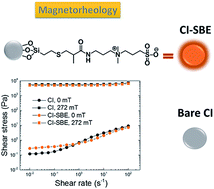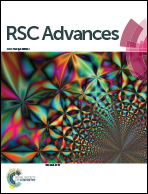Carbonyl iron coated with a sulfobetaine moiety as a biocompatible system and the magnetorheological performance of its silicone oil suspensions
Abstract
In this study, surface modification of carbonyl iron (CI) particles with sulfobetaine moieties (SBE) was performed by the silanization of activated CI to form stable CI–SBE particles. The modification led to a significant improvement of the thermo-oxidation stability and a negligible suppression of the magnetization of the particles, as revealed by thermogravimetric analysis and vibrating sample magnetometry, respectively. The effect of a magnetic field and temperature on the magnetorheological performance of particle suspensions was investigated using a rotational rheometer in order to clarify the suitability of these systems for the local embolization of blood veins. The suspension based on CI–SBE exhibited a pseudoplastic behaviour and a tunable yield stress in a range from 0.3–4 kPa at the normal human body temperature. Moreover, cell viability for fibroblasts and macrophages was examined via MTT assay, which revealed their suitability for the intended applications for the local embolization of blood veins.


 Please wait while we load your content...
Please wait while we load your content...